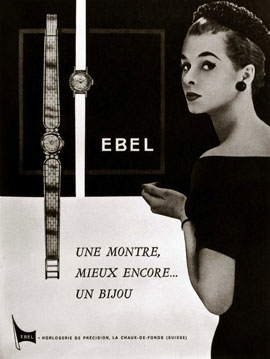

ebel
Historique de la maison d'horlogerie Ebel
Les premiers Architectes du Temps, qui créent la société le 15 juillet 1911, sont partenaires à la fois dans la vie et dans cette noble entreprise. Installés à La Chaux-de-Fonds, l'un des plus grands centres de l'horlogerie suisse, Eugène Blum et Alice Lévy décident de sceller leurs destins en s'associant dans une nouvelle aventure et donnent à leur société un nom symbolisant la fusion de leurs personnalités exceptionnelles : EBEL – les initiales de “Eugène Blum Et Lévy”.
Le fils des fondateurs, Charles Blum, travaille durement pour accroître la compétitivité de la marque et crée un site de production capable de vendre ses mouvements à d'autres marques de renommée internationale. L'absence de compromis sur la qualité est considérée comme la clé du succès dans ce métier exigeant.
Ebel fait preuve de son engagement à l'égard de cette valeur fondamentale en 1935 en devenant la première manufacture horlogère suisse à utiliser le système 'Western Electric'. Cette invention, ancêtre du vibrographe, est le premier appareil capable de mesurer la précision des mouvements. Toujours dans cette même quête de perfection, admirablement promue par le très talentueux horloger Marcel Reuche, Ebel encourage la création du “Contrôle Technique des Montres” (CTM) en 1957, série de contrôles douaniers sévères garantissant la précision de l'horlogerie suisse dans le monde entier.
Le CTM va contribuer à son tour à améliorer les critères de certification qualité du Contrôle Officiel Suisse des Chronomètres (COSC), organe officiel accordant l'attestation qui est aujourd'hui encore un prestigieux gage de précision et de fiabilité.
Pendant la Deuxième Guerre mondiale, Ebel devient le principal fournisseur de montres de l'armée britannique.
Ebel emprunte définitivement le chemin de la réussite internationale lorsque Pierre-Alain Blum, interrompant sa carrière aux États-Unis à l’appel de son père Charles, prend la direction de la société. Sa forte personnalité, son esprit pionnier et son tempérament visionnaire propulsent Ebel dans les hautes sphères du luxe international et offrent, grâce à ses efforts, un essor spectaculaire à la marque.
The first Architects of Time, who laid the company foundations on July 15, 1911, were a man and a woman, partners in life and in business. Settled in La Chaux-de-Fonds, one of the major centers of Swiss watch-making, Eugène Blum and Alice Lévy decided to seal their destinies in an entirely novel way. The name of the watch-making firm they established symbolized its unique origins in the fusion of two outstanding personalities: EBEL – an acronym of the initials “Eugène Blum Et Lévy”.
The founders’ son, Charles Blum, worked to hone the brand’s competitive edge while creating a production facility capable of selling its movements to other internationally famous brands. Uncompromising quality was already seen as the key to success within a demanding profession, and Ebel illustrated its dedication to this fundamental value in 1935 by becoming the first Swiss watch company to use the Western Electric System. The latter invention, a precursor of the vibrograph, was the first device capable of accurately measuring and testing rating precision.

As part of the same drive for perfection, admirably promoted by the highly talented watchmaker Marcel Reuche, Ebel encouraged the creation of the “Contrôle Technique des Montres” (CTM) in 1957, involving stringent customs controls that guaranteed Swiss watch-making precision throughout the world. The CTM also made a significant contribution to enhancing the quality control criteria of the Swiss Official Chronometer Testing Institute (COSC), the official body conferring the certification that continues today to represent a prestigious assurance of accuracy and reliability.
During World War II, Ebel became the main supplier of watches to the British Army, which provided eloquent testimony to the strength of the reputation it was so patiently and carefully establishing.
Ebel definitely took the path of international business when Pierre-Alain Blum, called back from his career in the United States by his father Charles Blum, was at the head of the company. His strong personality, pioneering spirit and visionary impetus were to raise Ebel to new heights within the international luxury world, helping the brand to achieve spectacular development.